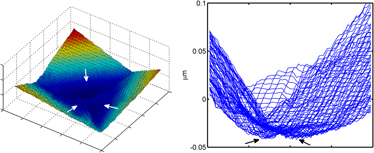Crossref Citations
This article has been cited by the following publications. This list is generated based on data provided by
Crossref.
Wan, Jiahuan
Xu, Linyan
Wu, Sen
and
Hu, Xiaodong
2014.
Investigation on Blind Tip Reconstruction Errors Caused by Sample Features.
Sensors,
Vol. 14,
Issue. 12,
p.
23159.
Sahu, Bijoyraj
Riddle, Robert O.
Ross, Daniel
Sheplak, Mark
Leang, Kam K.
and
Taylor, Curtis R.
2015.
Design and Analysis of Scanning Probe Microscopy Cantilevers With Microthermal Actuation.
Journal of Microelectromechanical Systems,
Vol. 24,
Issue. 6,
p.
1768.
Li, Yinrui
Li, Dongmeng
Yang, Jing
Luo, Hui
Chen, Fu
Wang, Xian
and
Gong, Rongzhou
2018.
Enhanced Microwave Absorption and Surface Wave Attenuation Properties of Co0.5Ni0.5Fe2O4 Fibers/Reduced Graphene Oxide Composites.
Materials,
Vol. 11,
Issue. 4,
p.
508.
Dushaq, Ghada
Nayfeh, Ammar
and
Rasras, Mahmoud
2019.
Hexagonal germanium formation at room temperature using controlled penetration depth nano-indentation.
Scientific Reports,
Vol. 9,
Issue. 1,
Dushaq, Ghada
and
Rasras, Mahmoud
2019.
Mechanical Nano-Patterning: Toward Highly-Aligned Ge Self-Assembly on Low Lattice Mismatched GaAs Substrate.
Scientific Reports,
Vol. 9,
Issue. 1,
Dushaq, Ghada
Paredes, Bruna
and
Rasras, Mahmoud
2020.
Strong enhancement of direct transition photoluminescence at room temperature for highly tensile-strained Ge decorated using 5 nm gold nanoparticles.
Nanotechnology,
Vol. 31,
Issue. 31,
p.
315201.
Madej, Lukasz
Legwand, Adam
Setty, Mohan
Mojzeszko, Mateusz
Perzyński, Konrad
Roskosz, Stanislaw
and
Chrapoński, Jacek
2021.
Evaluation of capabilities of the nanoindentation test in the determination of flow stress characteristics of the matrix material in porous sinters.
Archives of Civil and Mechanical Engineering,
Vol. 22,
Issue. 1,
Chudoba, Thomas
Schwenk, Dieter
Reinstädt, Philipp
and
Griepentrog, Michael
2022.
High-Precision Calibration of Indenter Area Function and Instrument Compliance.
JOM,
Vol. 74,
Issue. 6,
p.
2179.
Kovář, Jaroslav
Fuis, Vladimír
Čtvrtlík, Radim
and
Tomáštík, Jan
2022.
The discrepancy between the indentation curves obtained by the finite element method calculation with a Berkovich and a conical indenter.
Journal of Materials Research,
Vol. 37,
Issue. 10,
p.
1750.
Guan, Guangzhao
Coates, Dawn E.
Sun, Qing
Cannon, Richard D.
and
Mei, Li
2025.
Atomic Force Microscopy for Revealing Oncological Nanomechanobiology and Thermodynamics.
ACS Nano,
Vol. 19,
Issue. 11,
p.
10862.
